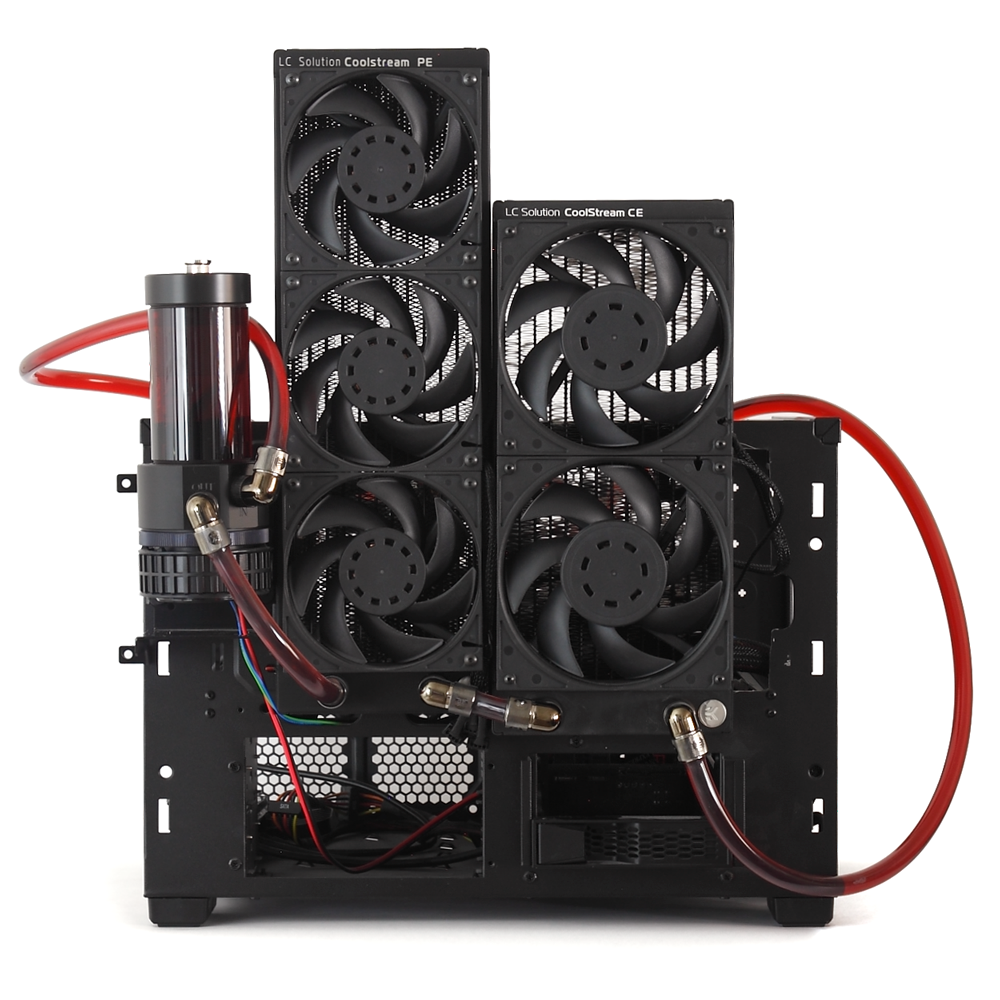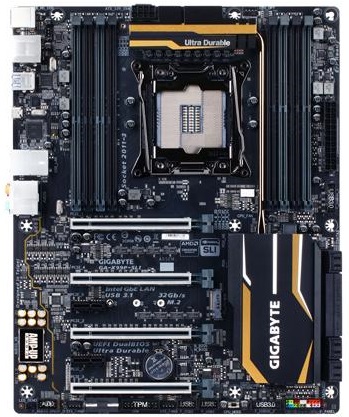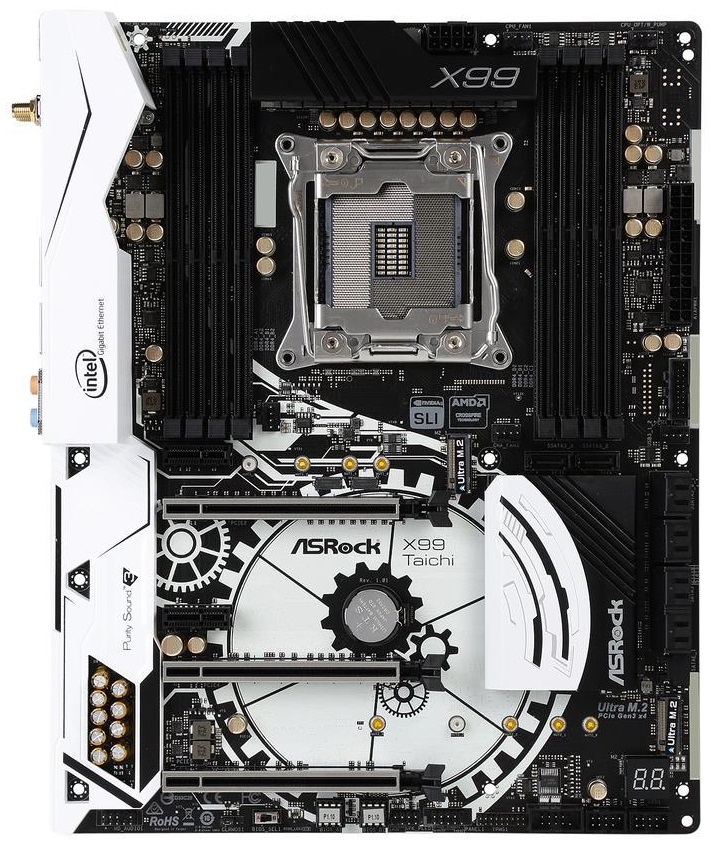MSI X99A Gaming Pro Carbon Motherboard Review
Why you can trust Tom's Hardware
How We Test
Shifting our testing image to Windows 10 was the perfect time to also update some of the hardware on the X99 test bed. For a quick summary, we've changed some benching software and upgraded the CPU, CPU cooler, RAM, and SSD.
Test System Configuration
| CPU Cooler | Waterblock - EK Supremacy Evo (Insert 2, Jet 3) Radiator - EK CE280 and PE360 Fans - EK F3-140ER (2) and EK F4-120ER (3) Pump - D5 PWM G2 Reservoir - EK XRES 140 Revo (200 mL) Tubing - 13/10 DuraClear |
| Sound | Integrated HD Audio |
| Network | Integrated Gigabit Networking |
| Power | Antec HCP-1200: ATX12V v2.3, EPS12V, 80 PLUS Gold |
| Software | |
| OS | Windows 10 64-bit |
| Graphics | Crimson 16.10.1 WHQL |
The CPU isn't the only new hardware for the X99 bed. We've retired the old Samsung SATA SSD in favor of Toshiba's RD400 NVMe model and its PCIe 3.0 x4 interface. The GPU cooling loop is now upgraded and expanded to include the CPU. The new "Frakencooler" features EK's Supremacy Evo block, D5 pump with 200mL reservoir, CE 240 radiator, PE 360 radiator, and an entire liter of coolant. A little Dremel work allowed both to mount to the stripped HAF xB Evo case used to hold the test bed together. This replaces Noctua's venerable D14 (though the Frakencooler has assimilated the D14's cable splitters and extensions).
Comparison Products
Benchmark Suite
| Benchmark Settings | |
| Synthetic Benchmarks and Settings | |
| PCMark 8 | Version 2.7.613 Home, Creative, Work, Storage, Applications (Adobe & Microsoft) |
| 3DMark 13 | Version 4.47.597.0 Skydiver, Firestrike, Firestrike Extreme Default Presets |
| SiSoftware Sandra | Version 2016.03.22.21 CPU Arithmetic, Multimedia, Cryptography, Memory Bandwidth |
| DiskSPD | 4k Random Read, 4k Random Write 128k Sequential Read, 128k Sequential Write |
| Cinebench R15 | Build RC83328DEMO OpenGL Benchmark |
| CompuBench | Version 1.5.8 Face Detection, Optical Flow, Ocean Surface, Ray Tracing |
| Application Tests and Settings | |
| LAME MP3 | Version 3.98.3 Mixed 271MB WAV to mp3: Command: -b 160 --nores (160 Kb/s) |
| HandBrake CLI | Version: 0.9.9 Sintel Open Movie Project: 4.19 GB 4k mkv to x265 mp4 |
| Blender | Version 2.68a BMW 27 CPU Render Benchmark, BMW 27 GPU Render Benchmark |
| 7-Zip | Version 16.02 THG-Workload (7.6 GB) to .7z, command line switches "a -t7z -r -m0=LZMA2 -mx=9" |
| Adobe After Effects CC | Release 2015.3.0, Version 13.8.0.144 PCMark driven routine |
| Adobe Photoshop CC | Release 2015.5.0. 20160603.r.88 x64 PCMark driven routine (light and heavy) |
| Adobe InDesign CC | Release 2015.4, Build 11.4.0.90 x64 PCMark driven routine |
| Adobe Illustrator | Release 2015.3.0, Version 20.0.0 (64-bit) PCMark driven routine |
| Game Tests and Settings | |
| Ashes of Singularity | Version 1.31.21360, DirectX 12, GPU-Focused High Preset Crazy Preset |
| F1 2015 | 2015 Season, Abu Dhabi Track, Rain Medium Preset Ultra High Preset |
| Metro Last Light Redux | Version 3.00 64-bit High Quality Very High Quality |
| The Talos Principle | Version 267252, 64-Bit, DirectX11 High Preset, Max Render 1920x1080 Ultra Preset, Max Render 1920x1080 |
With the adoption of our new X99 bed, testing methodology has changed slightly. With Turbo Boost 3.0, more boards are using their own boost profiles instead of Intel's recommended multipliers. Each motherboard is now explicitly set to 100 MHz BCLK with a fixed 35 multiplier for all performance benchmarks. When testing power consumption and heat generation, one 140mm fan on the liquid cooling array is set to 100% while all others are disabled. Speed Step and energy saving features are enabled where possible. Windows' default "Performance" power option preset is used for every test except idle power consumption, which uses "Balanced."
MORE: Best Motherboards
MORE: How To Choose A Motherboard
MORE: All Motherboard Content
Get Tom's Hardware's best news and in-depth reviews, straight to your inbox.
-
JamesSneed Must admit its an odd time to be reviewing a X99 board with the X299 boards imminent.Reply -
AgentLozen Reply
The same thought occured to me also. I feel like Broadwell-E CPUs just don't make any sense right now with Ryzen on the market. I was go as far as to say that if you were building a high end desktop, buying Broadwell-E is a bad investment.Jamessneed said:Must admit its an odd time to be reviewing a X99 board with the X299 boards iminent. -
JamesSneed Reply19824098 said:
The same thought occured to me also. I feel like Broadwell-E CPUs just don't make any sense right now with Ryzen on the market. I was go as far as to say that if you were building a high end desktop, buying Broadwell-E is a bad investment.Jamessneed said:Must admit its an odd time to be reviewing a X99 board with the X299 boards iminent.
Not so much Ryzen, its that the Skylake-x embargo lifts this coming Monday. Then the new HEDT X299 platform will be hitting shelves in two weeks. Its mostly pointless to be reviewing something that is obsolete in three days in my opinion. I would venture to guess the Broadwell-E sales between now and two weeks are pretty much dead knowing you have a cheaper and faster Skylake-X immanent.
-
dstarr3 It's a good thing I built my new computer just a couple years ago. I can wait until this RGB fad is mercifully over before having to build a new one.Reply -
JamesSneed Reply19824261 said:It's a good thing I built my new computer just a couple years ago. I can wait until this RGB fad is mercifully over before having to build a new one.
Yeah well I need a new PC so I'm in the other camp. At least it can be turned off. I just wish they did the LED thing with useful intent. Say back lighting your front panel ports and back ports so you can see where plug stuff even its its pretty dark for those of us who have our cases under desks. The ASUS Zenith board put a color coded LED in each 3.5mm audio ports on the back so you can see where to plug stuff in low light, this kind of thing would be nice.
-
artk2219 Honestly I kind of feel bad for the reviewer, he probably worked on this review for some time, only for us to all basically scratch our heads and ask why? With Ryzen out, and Core I9 and Threadripper releasing in a very short amount of time X99 is basically a dead platform, one that no one should be moving to unless your replacing a broken board, and dont feel like making a bigger change. But even then, this board alone is the price of a Ryzen 1600 and motherboard, and you could probably reuse the DDR 4 from the previous build (if it was broadwell or haswell based).Reply -
RedJaron Not all reviews are posted the instant they're completed. If there's some kind of exclusive, such as a new GPU launch or tradeshow news, those will usually bump basic product reviews down. With the 1080 Ti reviews, Computex, and E3 recently, amid other things, this got delayed.Reply -
JamesSneed Reply19824860 said:Not all reviews are posted the instant they're completed. If there's some kind of exclusive, such as a new GPU launch or tradeshow news, those will usually bump basic product reviews down. With the 1080 Ti reviews, Computex, and E3 recently, amid other things, this got delayed.
The board came out 6 months ago. :??: -
shrapnel_indie MSI X99A Gaming Pro Carbon: The board being reviewed here.Reply
ASRock X99 Taichi: Can't find a review on this site for it at all. Where is its review on this site?
Gigabyte GA-X99P-SLI: Can't find a review on this site for it at all. Where is its review on this site? -
the nerd 389 $280 and no PWM support on the pump header or case headers?Reply
MSI should be ashamed of themselves. I can, begrudgingly, forgive them for not putting PWM on the case fan headers, but the pump header? Really? There's no excuse for that at any price. That goes beyond terrible engineering, and is possibly even worthy of a class-action lawsuit.
After all, if you put a build together with the assumption that the pump header is suitable for pumps, you could destroy the pump and it would be entirely the fault of the motherboard. Depending on the build, the loss of a pump could cause a cascade failure in the CPU and corruption of the OS.


